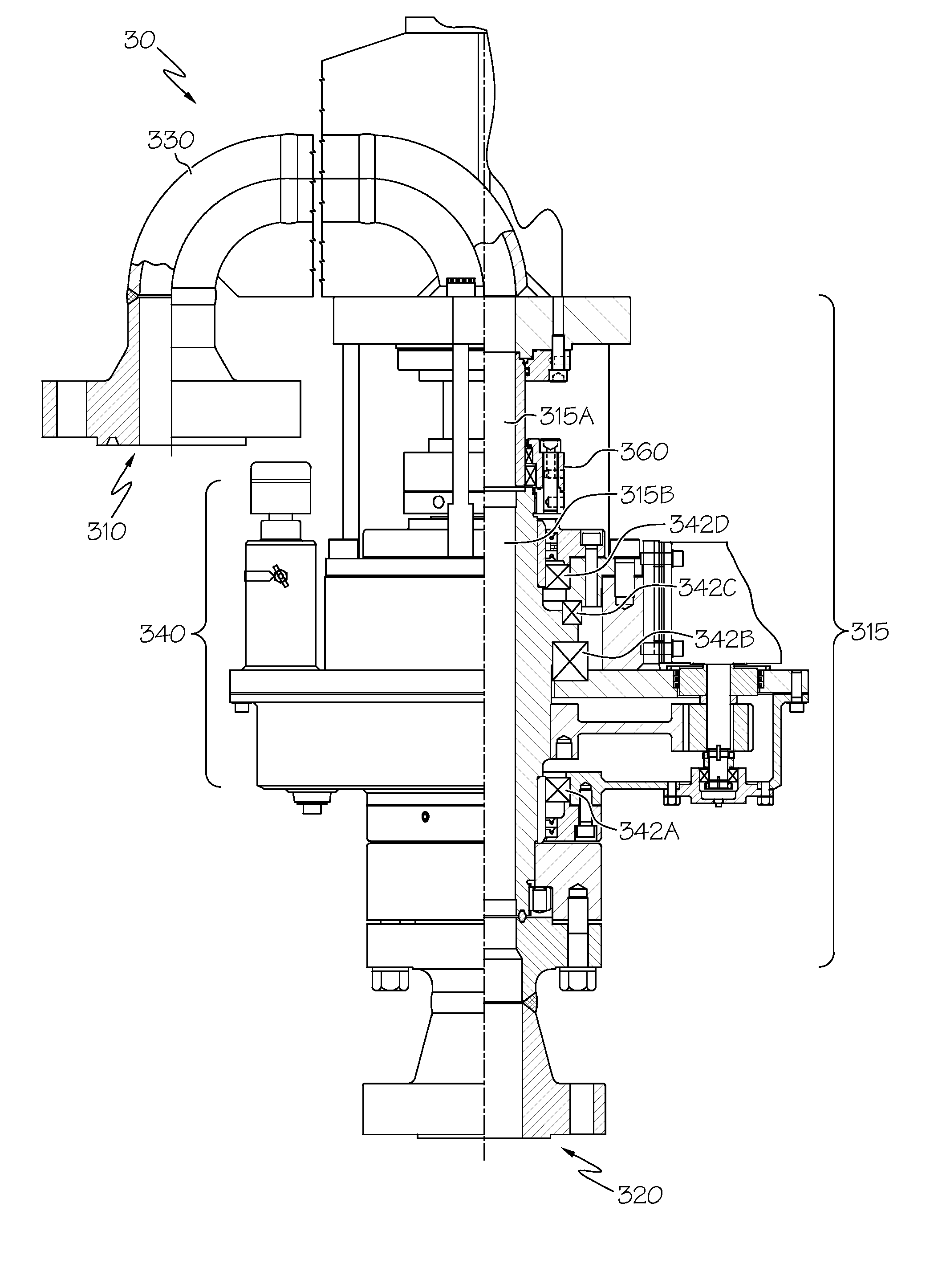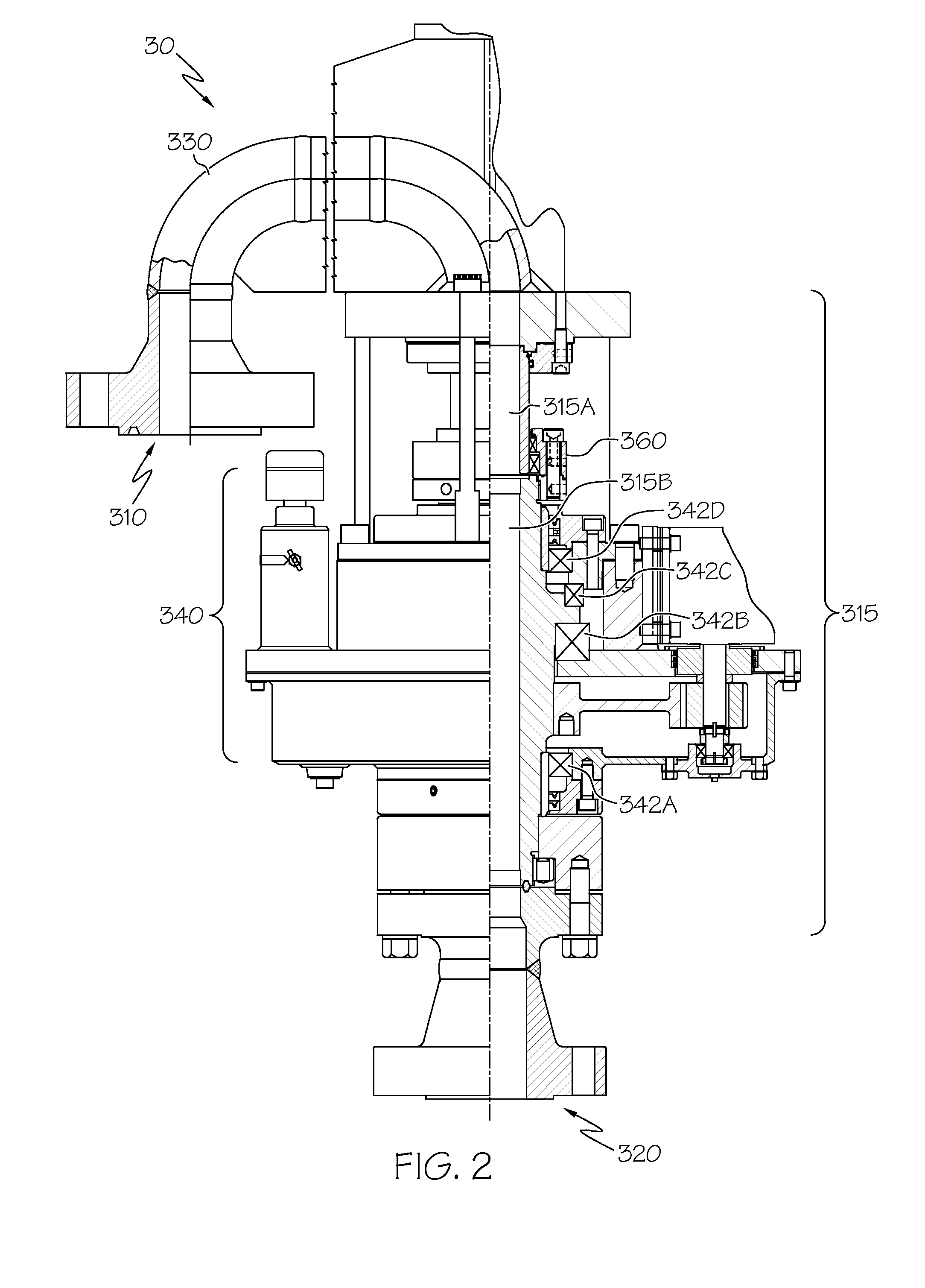[0007]These desires are met by the present invention, where an
assembly includes one or more primary seals and one or more secondary seals spaced apart from the primary seals. The primary seals actively seal the rotary joint, and a space between the primary and secondary seals is vented to
atmosphere during normal operation and allows a failure of the primary seal to be detected. The secondary seals remain inactive during normal rotary joint operation, but once leakage from the primary seal is detected, the vent can be closed, activating the secondary seal. The secondary seal then allows continued operation of the rotary joint until the next planned outage. Closure of the vent is a simple process which has little
impact on the coke removal time and mitigates any commercial
impact on the
refinery due to seal failure and change out.
[0009]Optionally, the selective venting communication means is a valve. In one form, a tortuous channel is set up such that any jetting action caused by the leakage being vented to the
atmosphere is converted to substantially nonjetting leakage
stream. In this way, risk of
direct exposure to a
high pressure jet of leaked fluid is reduced or eliminated. This can be effected by having a
discharge hole or related orifice be adjacent a
cavity wall such that the jetting of the discharged leakage through the hole impinges on the wall, causing
diffusion of the jet. Additional flow impediments, such as deflectors, can be used to further cause jet
diffusion. The assembly may also include a
locking mechanism such that once a valve or related selective venting communication means is placed in a particular open or closed position, that position cannot be inadvertently changed. In this way, operator error or vibration due to prolonged operation will not cause the selective venting communication means to change position.
[0011]According to another aspect of the present invention, a decoking tool is disclosed. The tool includes a
fluid supply conduit with one or more fluid dispensing nozzles fluidly connected to the
fluid supply conduit. The tool also includes, between the
fluid supply conduit and the fluid dispensing nozzles, a rotary joint made up of a rotatable flowpath, a non-rotatable flowpath and a seal assembly disposed between the rotatable and non-rotatable flowpaths. In this way, the rotary joint allows the fluid dispensing nozzles to rotate relative to the fluid supply conduit, where such rotary motion allows the fluid dispensing
nozzle or nozzles to perform at least one of a boring and
cutting operation on solidified coke, such as that found in a coke vessel or drum. Such rotary motion improves the ability of the fluid to
cut or bore into the solidified coke.
[0012]The seal assembly is made up of seals to prevent leakage of
high pressure fluid (such as water used in a decoking operation) between the rotatable and non-rotatable flowpaths. These seals include a primary seal and a secondary seal disposed relative to the primary seal such that in the event of leakage past the primary seal or seals that exceeds a threshold level, a selective venting device placed in fluid communication with the space between the primary and secondary seals can be adjusted to change the amount of venting between such space and the ambient
atmosphere. As mentioned above, such fluid dispensing
nozzle of the tool can be a single
nozzle or a combination, such as a cutting nozzle and a boring nozzle, where the latter is used to form a path along the substantially longitudinal dimension of a coke vessel while the former is used to rotate about the longitudinal axis such that water emanating therefrom can form radial cuts into the solidified coke. The device to effect the selective venting communication between the space and the ambient atmosphere may be in the form of a valve (such as a bleed valve) such that in a first operating condition, a vent is left open to the atmosphere so that the secondary seal is not pressurized or otherwise activated, while in a second operating condition, the vent is closed so that the secondary seal is activated. This activation of the secondary seal accompanies the recirculation and containment of the fluid that has leaked past the primary seal so that the leakage past the primary seal continues to be contained.
[0013]Optionally, the selective venting communication may be manually or automatically adjustable. In the case of the former, it can be configured as an adjustable valve with a plug,
stopcock or related flow control mechanism that allows an operator, upon attainment of a threshold leakage level past the primary seal or seals, to adjust the valve at a time that minimizes impact on the operation of the decoking tool. In the case of the latter, the tool may further include a leakage sensing device that can be used in conjunction with the valve (and related
control equipment) to measure leakage levels. Such sensor may deliver the measured level to an
output device, such as a gauge, readout screen, audible warning device or the like so that an operator or control mechanism (such as a
microprocessor-controlled
system) can make appropriate adjustments. Regardless of whether a sensor is included, the valve may further include a lock to keep the valve in one of an open position or a closed position so that the position cannot be inadvertently changed, such as by vibration,
human error or the like. The lock may include
safety wire or other device that both keeps the valve in a preferred position, as well as enable ease of adjustment by an operator.
 Login to View More
Login to View More  Login to View More
Login to View More 


